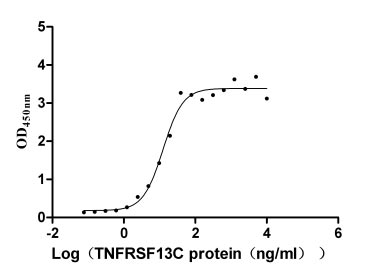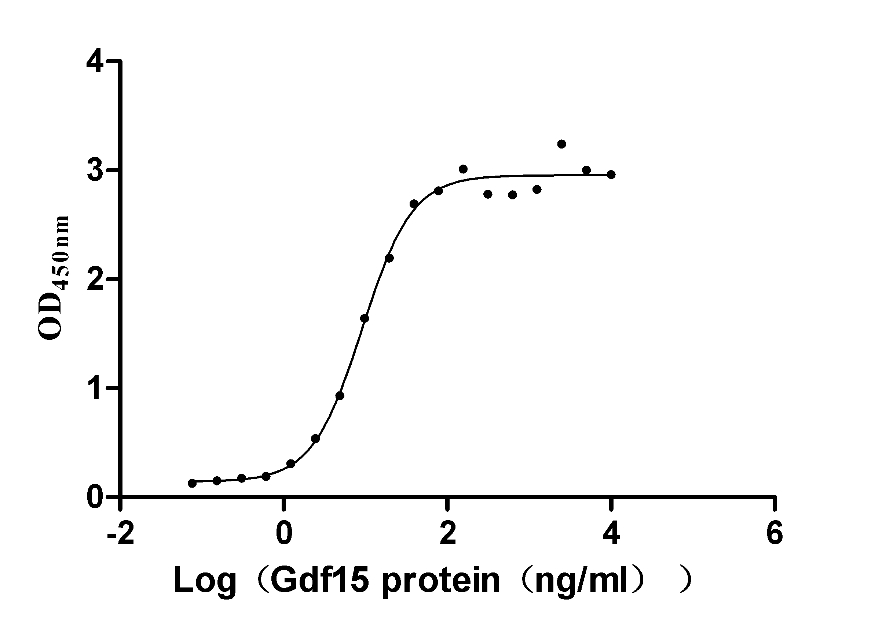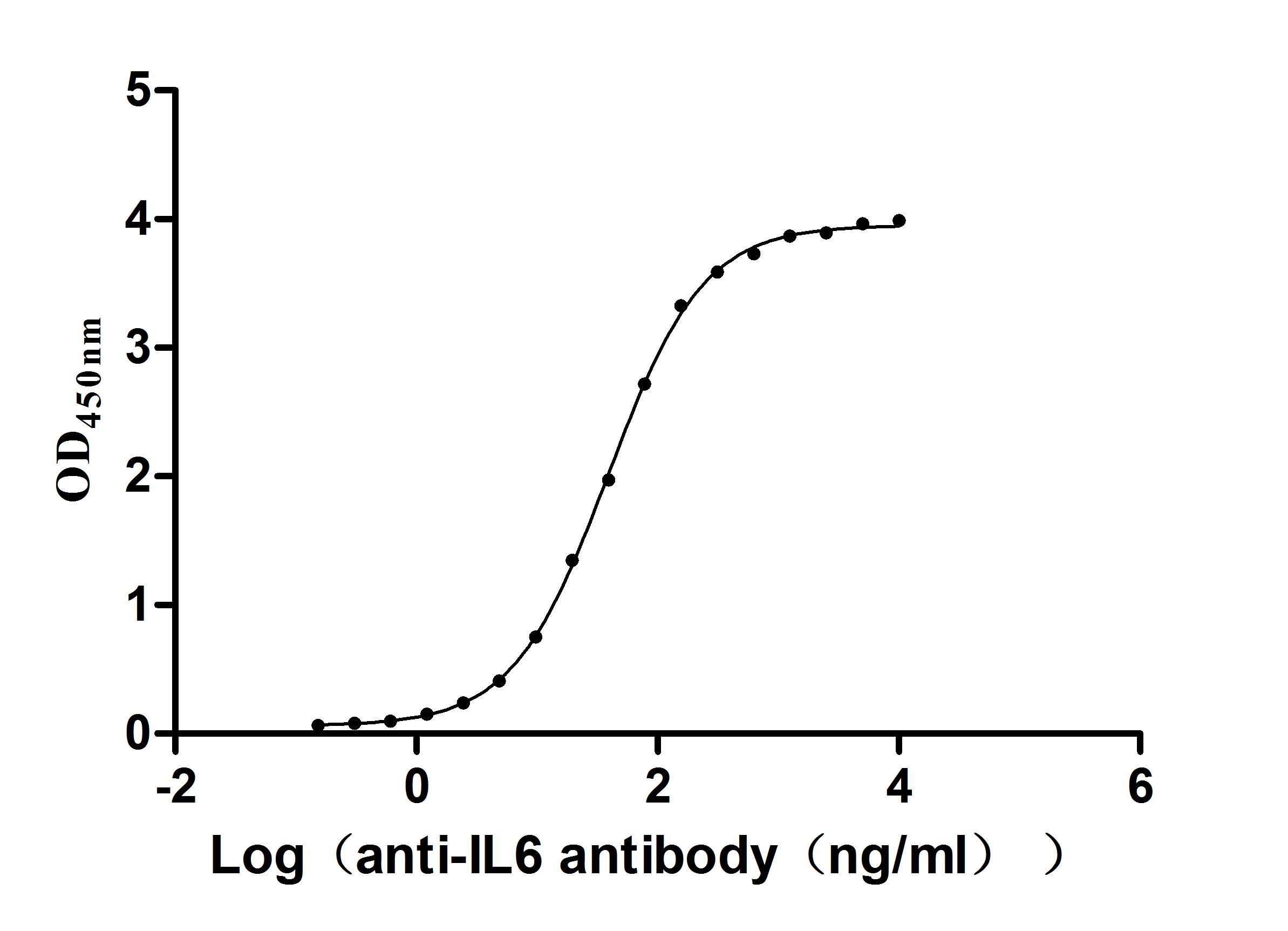Recombinant Mouse ATP-binding cassette sub-family G member 1 (Abcg1), partial
-
货号:CSB-YP714487MO1
-
规格:
-
来源:Yeast
-
其他:
-
货号:CSB-EP714487MO1
-
规格:
-
来源:E.coli
-
其他:
-
货号:CSB-EP714487MO1-B
-
规格:
-
来源:E.coli
-
共轭:Avi-tag Biotinylated
E. coli biotin ligase (BirA) is highly specific in covalently attaching biotin to the 15 amino acid AviTag peptide. This recombinant protein was biotinylated in vivo by AviTag-BirA technology, which method is BriA catalyzes amide linkage between the biotin and the specific lysine of the AviTag.
-
其他:
-
货号:CSB-BP714487MO1
-
规格:
-
来源:Baculovirus
-
其他:
-
货号:CSB-MP714487MO1
-
规格:
-
来源:Mammalian cell
-
其他:
产品详情
-
纯度:>85% (SDS-PAGE)
-
基因名:
-
Uniprot No.:
-
别名:Abcg1; Abc8; Wht1; ATP-binding cassette sub-family G member 1; ATP-binding cassette transporter 8; White protein homolog
-
种属:Mus musculus (Mouse)
-
蛋白长度:Partial
-
蛋白标签:Tag type will be determined during the manufacturing process.
The tag type will be determined during production process. If you have specified tag type, please tell us and we will develop the specified tag preferentially. -
产品提供形式:Lyophilized powder
Note: We will preferentially ship the format that we have in stock, however, if you have any special requirement for the format, please remark your requirement when placing the order, we will prepare according to your demand. -
复溶:We recommend that this vial be briefly centrifuged prior to opening to bring the contents to the bottom. Please reconstitute protein in deionized sterile water to a concentration of 0.1-1.0 mg/mL.We recommend to add 5-50% of glycerol (final concentration) and aliquot for long-term storage at -20℃/-80℃. Our default final concentration of glycerol is 50%. Customers could use it as reference.
-
储存条件:Store at -20°C/-80°C upon receipt, aliquoting is necessary for mutiple use. Avoid repeated freeze-thaw cycles.
-
保质期:The shelf life is related to many factors, storage state, buffer ingredients, storage temperature and the stability of the protein itself.
Generally, the shelf life of liquid form is 6 months at -20°C/-80°C. The shelf life of lyophilized form is 12 months at -20°C/-80°C. -
货期:Delivery time may differ from different purchasing way or location, please kindly consult your local distributors for specific delivery time.Note: All of our proteins are default shipped with normal blue ice packs, if you request to ship with dry ice, please communicate with us in advance and extra fees will be charged.
-
注意事项:Repeated freezing and thawing is not recommended. Store working aliquots at 4°C for up to one week.
-
Datasheet :Please contact us to get it.
相关产品
靶点详情
-
功能:Catalyzes the efflux of phospholipids such as sphingomyelin, cholesterol and its oxygenated derivatives like 7beta-hydroxycholesterol and this transport is coupled to hydrolysis of ATP. The lipid efflux is ALB-dependent. Is an active component of the macrophage lipid export complex. Could also be involved in intracellular lipid transport processes. The role in cellular lipid homeostasis may not be limited to macrophages. Prevents cell death by transporting cytotoxic 7beta-hydroxycholesterol.
-
基因功能参考文献:
- HSP70 promotes the progression of atherosclerosis in apoE-/- mice by suppressing the expression of ABCA1 and ABCG1 through the JNK/Elk-1 pathway. PMID: 29678642
- TMP upregulated the protein stability of ABCA1 without affecting ABCG1. Accordingly, TMP regulated the expression of SR-A, CD36, ABCA1 and ABCG1 in aortas of ApoE-/- mice, which resembled the findings observed in macrophages. PMID: 28791414
- ABCG1 regulates pulmonary surfactant metabolism PMID: 28264879
- ABCG1 regulates T cell differentiation into Tregs, highlighting a pathway by which cholesterol accumulation can influence T cell homeostasis in atherosclerosis PMID: 27482882
- Our data indicate that a combination of vildagliptin and pravastatin significantly induces the expression of LXR-ABCA1/ABCG1 cascade and improves cholesterol efflux (P > 0.05) in adipocytes. Our data may explain, at least in part, the improvement in HDL-C levels observed in patients receiving both medications PMID: 27251372
- ABCG1 may play a protective role in early-stage atherosclerosis by reducing endothelial activation induced by oscillatory shear stress via suppressing the inflammatory response. PMID: 27297110
- Endothelial cholesterol efflux pathways mediated by ABCA1 and ABCG1 are nonredundant and atheroprotective, reflecting preservation of endothelial NO synthase activity and suppression of endothelial inflammation, especially in regions of disturbed arterial blood flow. PMID: 27199450
- ABCG1, irrespective of either a leucine or proline at position 550, is an intracellular protein that localizes to vesicles of the endosomal pathway where it functions to mobilize sterols away from the endoplasmic reticulum and out of the cell. PMID: 27230131
- our study suggests that MEK1/2 inhibitors activate macrophage ABCG1 expression/RCT, and inhibit foam cell formation and lesion development by multiple mechanisms, supporting the concept that ERK1/2 inhibition is anti-atherogenic PMID: 27365310
- miR-33 augments macrophage lipid rafts and enhances proinflammatory cytokine induction and NF-kappaB activation by LPS. This occurs through an ABCA1- and ABCG1-dependent mechanism and is reversible by interventions upon raft cholesterol and by ABC transporter-inducing liver X receptor agonists. PMID: 27471270
- ABCG1 expression was down-regulated by TLR4, which induces inflammation and lipid accumulation in vascular smooth muscle cells via PPARgamma/LXRalpha signaling. PMID: 27807703
- Visfatin upregulated CD36 and SRA expression and downregulated ABCA1 and ABCG1 expression, subsequently increased ox-LDL uptake and decreased cholesterol efflux, and finally promoted foam cell formation via the PI3K- and ERK-dependent pathways. PMID: 26536203
- Leu at position 550/562 in mABCG1/hABCG1 is critical for their plasma membrane localization but not for ABCG1-mediated cholesterol efflux. PMID: 26695502
- 3beta,5alpha,6beta-cholestanetriol and 25-hydroxycholesterol are physiologic substrates for ABCG1 PMID: 24833118
- Our data suggest that GLP-1-based therapy modulate ABCA1/ABCG1 expression in adipocytes potentially through an LXR-alpha mediated process. PMID: 26603933
- The absence of ABCG1 inhibits tumour growth through modulation of macrophage function within the tumour, and illustrates a link between cholesterol homeostasis and cancer. PMID: 25724068
- data support the impact of genes from the Abcg1-U2af1 region as modifiers of Tc1-dependent memory and locomotor phenotypes in Tc1 mouse model of Down syndrome. PMID: 25706610
- HDL enhances transendothelial cholesterol transport by activation of a mechanism involving ABCA1, ABCG1 and SR-B1 but not involving PI3K and Akt. PMID: 26255968
- AOPPs increase accumulation of lipids and exacerbate atherosclerosis through downregulation of ABCA1 and ABCG1 expression, and the JAK-LXRalpha signaling pathway in apoE-KO mice. PMID: 25262842
- The role of cellular cholesterol transport proteins including adenosine triphosphate binding cassette transporter A1 (ABCA1), G1 (ABCG1) and scavenger receptor class B type I (SR-BI) in diabetic nephropathy, was determined. PMID: 25181357
- The study identifies a major role of adipocyte ABCG1 in adiposity and fat mass growth and suggests that adipose ABCG1 might represent a potential therapeutic target in obesity. PMID: 25249572
- ABCG1 is involved in cellular vitamin E efflux. PMID: 25462452
- Results of this study show that the ABC transporter ABCA1 (but not ABCG1) plays a role in the early remodeling process that ensues brain injury PMID: 24661912
- Data indicate that transgenic S100/calgranulin has no direct effect on cholesterol efflux in macrophages, but rather promotes IL-22 secretion, which reduces cholesterol efflux in macrophages by decreasing the expression of ABC transporter ABCG1. PMID: 24367046
- The expression of ABCG1 is suppressed by activation of NF-kappaB. PMID: 24360166
- found that ABCA1 and ABCG1 were expressed in all retinal cell types, and that their expression was decreased in Hfe(-/-) retina PMID: 24462739
- Anti-inflammatory effects of LXR activators are of key importance to their antiatherosclerotic effects in Ldlr knockout mice independent of cholesterol efflux pathways mediated by macrophage ABCA1/G1. PMID: 24311381
- MiR-128-2 inhibits the expression of ABCA1, ABCG1 and RXRalpha directly through a miR-128-2-binding site within their respective 3'untranslated regions. PMID: 23990020
- BMP macrophage accumulation reduced cholesterol efflux to both apolipoprotein A1 and high-density lipoprotein by 40% and correlated with a 40% decrease in mRNA contents of ABCA1, ABCG1, and liver-X receptor alpha and beta. PMID: 23788762
- Macrophage deficiency of ABCA1/G1 is proatherogenic by promoting plaque inflammation and a novel positive feedback loop in which cholesterol-laden splenic macrophages signal to produce monocytes, with suppression by macrophage cholesterol efflux pathways. PMID: 23572498
- Mice with defects in cholesterol efflux pathways due to deficiencies of the ATP binding cassette transporter ABCG1 displayed a dramatic increase in HSPC mobilization and extramedullary hematopoiesis. PMID: 22862945
- RAW 264.7 macrophage ABCA1 and ABCG1 expression was repressed by unsaturated fatty acids. PMID: 22209005
- posttranslational control is absent from the murine ABCG1 homolog. PMID: 22872754
- Changes in intracellular cholesterol homeostasis regulated by ABCG1 profoundly impact iNKT cell development and function. PMID: 23100511
- pathways for cholesterol trafficking out of adipose tissue involve adipose tissue macrophage egress as well as ABCG1 mediated cholesterol efflux PMID: 22179025
- ABCG1 controls LPL activity and promotes lipid accumulation in human macrophages in the presence of triglyceride-rich lipoproteins. PMID: 22772754
- ABCG1 coordinates airway adaptive immunity, with its deletion suppressing adaptive lung eosinophilia through an IL-17-dependent mechanism. PMID: 22539789
- Data indicate that hepatic nascent HDL formation is highly dependent on ABCA1 but not on ABCG1 or SR-BI. PMID: 22190590
- ABCG1 abscence leads to increased lesions in early atherosclerotic Ldl receptor-deficient mice, while in more advanced stages of atherosclerosis enhanced apoptosis and/or compensatory mechanisms lead to retarded lesion progression. PMID: 22196936
- Data demonstrate that ABCG1 is an intracellular sterol transporter that localizes to endocytic vesicles. PMID: 22095132
- ABCA1 and ABCG1 each make complimentary and important contributions to beta-cell function by maintaining islet cholesterol homeostasis in vivo. PMID: 22315310
- Our results indicate that stigmasterol increases ABCA1 and ABCG1 expression. PMID: 21111593
- study provided evidence that the ubiquitin-proteasome system is involved in ABCA1/G1 degradation PMID: 21817095
- observations indicate that calpain promotes ABCG1 degradation by cleaving cell surface-resident ABCG1, and consequently reduces the expression and cholesterol efflux function of ABCG1 PMID: 21295304
- LXRalpha-dependent upregulation of ABCA1 and ABCG1 may mediate the beneficial effect of alpha-LA on foam cell formation. PMID: 21034810
- Our data indicate that inflammatory remodeling of HDL impacts ABCG1-dependent efflux independent of serum amyloid A. PMID: 21138980
- Deletion of ABCA1 and ABCG1 impairs macrophage migration because of increased Rac1 signaling. PMID: 21148432
- ABCG1 is expressed in cultured human keratinocytes and murine epidermis PMID: 20675829
- atheroprotective role of vascular ABCG1, especially in the aortic arch, likely related to its role in the preservation of endothelial NO synthase activity. PMID: 20705913
- The overexpression of GX sPLA(2) significantly reduced ABCA1 and ABCG1 expression in J774 macrophage-like cells, whereas GX sPLA(2) deficiency in peritoneal macrophages was associated with enhanced expression. PMID: 20844270
显示更多
收起更多
-
亚细胞定位:Endoplasmic reticulum membrane; Multi-pass membrane protein. Golgi apparatus membrane; Multi-pass membrane protein. Cell membrane.
-
蛋白家族:ABC transporter superfamily, ABCG family, Eye pigment precursor importer (TC 3.A.1.204) subfamily
-
组织特异性:Expressed mainly in brain, thymus, lung, adrenals, spleen and placenta. Little or no expression in liver, kidney, heart, muscle or testes.
-
数据库链接:
KEGG: mmu:11307
STRING: 10090.ENSMUSP00000024829
UniGene: Mm.15691
Most popular with customers
-
Express system: Mammalian cell
Species: Homo sapiens (Human)
-
Recombinant Mouse GDNF family receptor alpha-like (Gfral), partial (Active)
Express system: Mammalian cell
Species: Mus musculus (Mouse)
-
Recombinant Human Complement component C1q receptor (CD93), partial (Active)
Express system: Mammalian cell
Species: Homo sapiens (Human)
-
Recombinant Human V-set and immunoglobulin domain-containing protein 4 (VSIG4), partial (Active)
Express system: Mammalian cell
Species: Homo sapiens (Human)
-
Recombinant Human Desmoglein-3 (DSG3), partial (Active)
Express system: Baculovirus
Species: Homo sapiens (Human)
-
Recombinant Human Myosin regulatory light chain 12B(MYL12B) (Active)
Express system: E.coli
Species: Homo sapiens (Human)
-
-
Recombinant Human Tumor necrosis factor ligand superfamily member 15(TNFSF15) (Active)
Express system: Mammalian cell
Species: Homo sapiens (Human)









-AC1.jpg)










